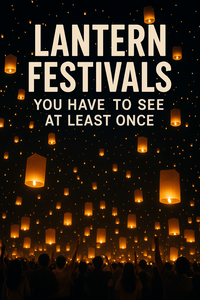


The first time I watched a lantern rise, I was standing ankle-deep in the grass outside Chiang Mai.
The first time I watched a lantern rise, I was standing ankle-deep in the grass outside Chiang Mai. Warm night air, hundreds of paper domes trembling like hearts in the dark, and then—release. They drifted upwards, slow at first, then suddenly countless, until the sky looked alive.
It’s impossible not to get emotional. You feel as if every tiny flame carries something of you: the goodbyes, the wishes, the “maybe next years.” Lantern festivals do that. They take the ordinary and make it sacred for a moment.
Over the years I’ve chased that same light across the world, from Thailand to Taiwan, from old Vietnamese towns to the neon edges of Seoul. Here are the ones that stayed with me.
Yi Peng isn’t really a tourist show; it’s an act of faith. Locals write small hopes on rice-paper lanterns and let them go in one graceful motion. Some cry. Some just stare upward, lost in the gold haze. The air smells faintly of lemongrass and smoke.
It happens in November, alongside the water-based festival Loy Krathong, so the rivers glow too. Fire above, fire below. You don’t just watch it—you disappear into it.
Pingxi sits in the hills east of Taipei, reached by an old branch-line train that rattles like it’s from another lifetime. The whole town smells of rain and fried tofu. During Lunar New Year, everyone crowds the tracks, painting wishes on giant paper lanterns before lighting them.
In this , I’ll introduce all 9 stops on the Pingxi train line, plus 2 more stops on the connecting Shen’ao Line, for a total of 11 fun stops
When they rise, you can hear the gasp ripple through the crowd. Each one turns tiny against the black mountains until they vanish completely. People stay staring long after the last flame fades, like they can still see their hopes drifting somewhere above the clouds.
If Chiang Mai feels like fire meeting air, Hoi An is water meeting light. Once a month, on the full moon, the old town goes dark—no streetlamps, no electric signs. Just soft coloured lanterns swaying over the river. Children sell little lotus-shaped candles that you set afloat with a quiet wish.
In Hoi An, Vietnam, the “lanterns that float, not fly” refers to the traditional water lanterns, which are made of paper in a lotus shape with a small candle at the base. Visitors can buy these for around 10,000 VND and release them on the Hoai River at night, often from the riverbank or a small boat, as a symbol of sending wishes for peace, health, and good fortune. These lanterns are different from the sky lanterns that fly away; they simply float on the water’s surface.
The river moves slowly there, and so do you. Locals hum old songs, tourists whisper, and for once in Southeast Asia nobody’s in a rush. You leave with wax on your fingertips and that calm sort of happiness that only comes from stillness.
February in Nagasaki feels like standing inside a painting. Fifteen thousand lanterns, dragons curling above shopfronts, the smell of steamed buns and sea air. The festival began with the Chinese community centuries ago but now the whole city joins in.
You wander through narrow streets lit crimson, stumble upon a lion dance, buy sweet sesame balls you didn’t know you needed. And when you look out toward the harbour, the reflections turn the water into liquid light. It’s loud, busy, absolutely human.
In November, the Cheonggyecheon Stream—a strip of water running through downtown Seoul—fills with giant illuminated figures. Tigers, phoenixes, heroes from Korean myths. Office workers stop on their way home, couples hold hands, and everyone takes far too many photos.
It’s colder there; you can see your breath mingle with the lantern light. The reflections move like brushstrokes. Somehow the city feels gentle for once.
Different continent, different purpose. Each May, thousands gather at Ala Moana Beach in Hawaii for the Lantern Floating Ceremony. People write messages to loved ones they’ve lost and send them across the Pacific at sunset. No music, just the hush of waves and the sound of quiet crying.
I stood there once, watching the lanterns drift away until they were only dots on the horizon. It felt less like grief, more like gratitude.
You don’t have to travel far. In Britain, Durham Lumiere turns cathedrals into light sculptures, and Canary Wharf’s Winter Lights glows like a digital garden. They might not involve wishes written on paper, but they remind us why we’re drawn to light in the first place.
Before any of these adventures, though, I’ve learnt one small but vital ritual: make the leaving easy. At airports, chaos kills wonder faster than jet lag. Services like meet and greet at Gatwick mean you can hand over your keys, skip the bus shuffle, and start your trip calm.
And yes—always compare airport parking deals. It sounds dull, but those few saved pounds often become the snack you share on a midnight riverbank somewhere, waiting for lanterns to rise.
Maybe lanterns speak to something ancient in us. They’re fragile—one gust and they’re gone—yet we keep lighting them anyway. Hope disguised as fire.
Every festival has its own reason: to honour ancestors, to celebrate harvests, to pray for luck. But beneath all that, it’s the same impulse—to send a bit of ourselves into the dark and trust it’ll find light.
When you stand beneath that glowing sky, you realise it’s not about photography or bucket lists. It’s about that quiet second when thousands of strangers share one small, wordless wish. And that’s something worth flying for.
